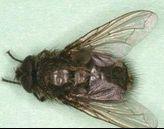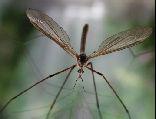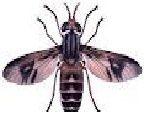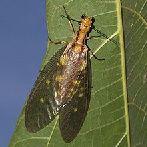Natural Solutions to Things That Bug You (54 page)
Read Natural Solutions to Things That Bug You Online
Authors: Myles Bader


 This fly has a shiny greenish-black body, big red eyes and a yellowish head and legs. The larvae are yellowish-white maggots. The maggots will hatch from eggs that are laid around the carrots crown. After they hatch they burrow down into the roots. The tunnels they make are rusty in color from the maggot’s excrement, which gives them their name. Their damage leads to soft-rot bacterial problems.
This fly has a shiny greenish-black body, big red eyes and a yellowish head and legs. The larvae are yellowish-white maggots. The maggots will hatch from eggs that are laid around the carrots crown. After they hatch they burrow down into the roots. The tunnels they make are rusty in color from the maggot’s excrement, which gives them their name. Their damage leads to soft-rot bacterial problems.
General Information:
This is a sneaky little fly that damages the plants underground and the damage is not noticeable until it’s too late. These flies love to munch on carrots, parsnips, celery, parsley, fennel and dill. The carrots will have minute tunnels with a light-colored fecal matter. These bugs hang out in the northeastern states, coastal Washington and parts of Oregon and Idaho. They will over winter in garden soil.
A SPOT OF TEA WITH YOUR SEEDS
Save your used tealeaves and place them into your carrot seeds when you plant. This will prevent any problems from carrot maggots.

PLANT REPELLANTS
There are a number of plants that when planted near the carrots and other similar vegetables will repel bugs. These include leek, onions, garlic, pennyroyal, rosemary, sage, black salsify and coriander.
DUST OFF THE PLANTS
If you prepare a dust composed of either wormwood or rock phosphate it will keep the flies from laying their eggs on the plants. The wormwood will mask the aroma of the carrots and the flies will avoid the plant.
TRAP ‘EM
You can purchase some yellow sticky traps at a garden supply house and insert the stakes into the soil at a 45
angle.
GIVE THEM A CUP OF JOE
When sowing the carrot seeds, just mix them with some used coffee grounds, which will repel the rust fly and stop them from laying their eggs.

CLUSTER FLY
 Custer flies are active in the fall when they fly to the sunny sides of homes in search of protected over-wintering sites and may be found flying about inside, often in great numbers all winter long. These flies do not reproduce within the structure, but become active on warm days and crawl out of wall voids and attics in a confused attempt to go back outside.
Custer flies are active in the fall when they fly to the sunny sides of homes in search of protected over-wintering sites and may be found flying about inside, often in great numbers all winter long. These flies do not reproduce within the structure, but become active on warm days and crawl out of wall voids and attics in a confused attempt to go back outside.
Cluster flies are thought to be native to Europe and may have found their way to North America in the ballast of ships containing soil and the cluster fly host, earthworms. Adult cluster flies are slightly larger than the common house fly but are dull-gray with black markings and have golden-yellow hairs on the thorax. The hairs are more numerous on the underside of the thorax between and near the legs.
The immature stages, egg and larva, are seldom seen as the eggs are deposited on the soil and the larva or maggots burrow into earthworms on which they feed. The maggots are cream colored and are an elongated wedge shape.
As a nuisance pest it
joins the ranks of other over-wintering pests such as the multicolored Asian lady beetle, the western conifer seed bug and the boxelder bug. Cluster flies will not damage your home, however, the flies may leave small dark-colored spots of excrement on windows and walls, but they are not known to carry any diseases of medical importance to humans.
CRANE FLY
 Crane fly adults are very slender, long-legged flies that may vary in length from 2–60 millimeters (0.079–2.4 in) though tropical species may exceed to 100 millimeters or 3.9 inches. The larvae can cause damage to lawns by feeding on the roots of grass plants. Numerous other common names have been applied to the crane fly, many of them more or less regional, including mosquito hawk, mosquito wolf, mosquito eater, soldier, gallon-nipper and golly-whopper.
Crane fly adults are very slender, long-legged flies that may vary in length from 2–60 millimeters (0.079–2.4 in) though tropical species may exceed to 100 millimeters or 3.9 inches. The larvae can cause damage to lawns by feeding on the roots of grass plants. Numerous other common names have been applied to the crane fly, many of them more or less regional, including mosquito hawk, mosquito wolf, mosquito eater, soldier, gallon-nipper and golly-whopper.
In appearance crane flies seem long and gangly, with very long legs, and a long slender abdomen. The wings are often held out when at rest.
Unlike most, crane flies are weak and poor fliers and tend to "wobble" in an unpredictable pattern during flight, and they can be caught without much effort.
Female abdomens contain eggs, and as a result appear swollen in comparison to those of males. The female abdomen also ends in a pointed ovipositor that may look somewhat like a stinger, but is completely harmless. Adult mouthparts may occur on the end of the crane fly's long face, which is sometimes called a snout.
Larvae have a distinct head capsule, and their abdominal segments often have long fleshy projections surrounding the posterior that resemble tentacles. Adult crane flies do not prey on mosquitoes, nor do they bite humans. Some larval crane flies are predatory and may eat mosquito larvae but mostly feed on nectar or they do not feed at all. Once they become adults, most crane fly species exist as adults only to mate and die.
Their larvae, called "leatherjackets", "leatherbacks", "leatherback bugs" or "leatherjacket slugs", because of the way they move, consume roots and other vegetation, in some cases causing damage to plants. The crane fly is occasionally considered a mild turf pest in some areas.
DEER FLY
 Deer flies (also known as yellow flies) can be pests to cattle, horses and humans. Distinguishing characteristic of a deer fly is patterned gold or green eyes. They are smaller than wasps and they have colored eyes and dark bands across their wings. While female deer flies feed on blood, males collect pollen. When feeding, females use knife-like mandibles and maxillae to make a cross-shaped incision and then lap up the blood.
Deer flies (also known as yellow flies) can be pests to cattle, horses and humans. Distinguishing characteristic of a deer fly is patterned gold or green eyes. They are smaller than wasps and they have colored eyes and dark bands across their wings. While female deer flies feed on blood, males collect pollen. When feeding, females use knife-like mandibles and maxillae to make a cross-shaped incision and then lap up the blood.
Their bite can be extremely painful, and allergic reaction from the saliva of the fly can result in further discomfort and health concerns. Pain and itch are the most common symptoms, but more significant allergic reactions can develop.
They are frequently found in damp environments, such as wetlands or forests and lay clusters of shiny black eggs on the leaves of small plants by water. The aquatic larvae feed on small insects and pupate in the mud at the edge of the water. Adults are potential vectors of tularemia, anthrax and filariasis. Predators of the deer fly include nest-building wasps and hornets, dragonflies and some birds including the killdeer.
DOBSONFLY
 Dobsonflies are found throughout the Americas and Asia, as well as South Africa. Both male and female dobsonflies can reach lengths up to five inches (12.5 cm), measured from the tips of their pincers to the tips of their four wings. Their wingspans can be twice as long as their body length and the wings are densely lined with intersecting veins. When not in use, the wings are folded along the length of their bodies. Dobsonflies also have long, multi-segmented antennae.
Dobsonflies are found throughout the Americas and Asia, as well as South Africa. Both male and female dobsonflies can reach lengths up to five inches (12.5 cm), measured from the tips of their pincers to the tips of their four wings. Their wingspans can be twice as long as their body length and the wings are densely lined with intersecting veins. When not in use, the wings are folded along the length of their bodies. Dobsonflies also have long, multi-segmented antennae.
